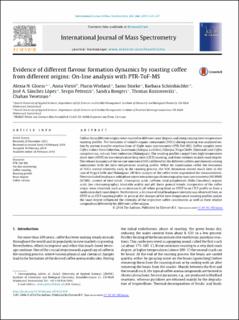Please use this identifier to cite or link to this item:
https://doi.org/10.21256/zhaw-1958Full metadata record
| DC Field | Value | Language |
|---|---|---|
| dc.contributor.author | Gloess, Alexia N. | - |
| dc.contributor.author | Vietri, Anita | - |
| dc.contributor.author | Wieland, Flurin | - |
| dc.contributor.author | Smrke, Samo | - |
| dc.contributor.author | Schönbächler, Barbara | - |
| dc.contributor.author | Sánchez López, José Antonio | - |
| dc.contributor.author | Petrozzi, Sergio | - |
| dc.contributor.author | Bongers, Sandra | - |
| dc.contributor.author | Koziorowski, Thomas | - |
| dc.contributor.author | Yeretzian, Chahan | - |
| dc.date.accessioned | 2018-04-23T09:04:33Z | - |
| dc.date.available | 2018-04-23T09:04:33Z | - |
| dc.date.issued | 2014-05-15 | - |
| dc.identifier.issn | 1387-3806 | de_CH |
| dc.identifier.issn | 1873-2798 | de_CH |
| dc.identifier.uri | https://digitalcollection.zhaw.ch/handle/11475/5460 | - |
| dc.description.abstract | Coffees from different origins were roasted to different roast degrees and along varying time temperature roasting profiles. The formation of volatile organic compounds (VOCs) during roasting was analyzed online by proton-transfer-reaction time-of-flight mass-spectrometry (PTR-ToF-MS). Coffee samples were Coffea arabica from Colombia, Guatemala (Antigua La Ceiba), Ethiopia (Yirga Cheffe, Djimmah) and Coffea canephora var. robusta from Indonesia (Malangsari). The roasting profiles ranged from high temperature short time (HTST) to low temperature long time (LTLT) roasting, and from medium to dark roast degree. The release dynamics of the on-line monitored VOCs differed for the different coffees and showed a strong modulation with the time–temperature roasting profile. While for Guatemalan coffee the formation of VOCs started relatively early in the roasting process, the VOC formation started much later in the case of Yirga Cheffe and Malangsari. Off-line analysis of the coffee brew augmented the measurements. These included headspace solid phase micro extraction gas chromatography mass spectrometry (HS SPME GC/MS), content of total solids, chlorogenic acids, caffeine, total polyphenols (Folin Ciocalteu), organic acids (ion chromatography), titratable acidity and pH. Some general trends, irrespective of the coffee origin, were observed, such as an increase in pH when going from an HTST to an LTLT profile or from a medium to dark roast degree. Furthermore, a decrease of total headspace intensity was observed from an HTST to an LTLT roasting profile. In general, the changes of the time temperature roasting profiles and/or the roast degree influenced the intensity of the respective coffee constituents as well as their relative composition differently for different coffee origins. | de_CH |
| dc.language.iso | en | de_CH |
| dc.publisher | Elsevier | de_CH |
| dc.relation.ispartof | International Journal of Mass Spectrometry | de_CH |
| dc.rights | https://creativecommons.org/licenses/by-nd/3.0/ | de_CH |
| dc.subject | Roasting | de_CH |
| dc.subject | Coffee | de_CH |
| dc.subject | PTR-ToF-MS | de_CH |
| dc.subject | On-line monitoring | de_CH |
| dc.subject.ddc | 663: Getränketechnologie | de_CH |
| dc.title | Evidence of different flavor formation dynamics by roasting coffee from different origins : on-line analysis with PTR-ToF-MS | de_CH |
| dc.type | Beitrag in wissenschaftlicher Zeitschrift | de_CH |
| dcterms.type | Text | de_CH |
| zhaw.departement | Life Sciences und Facility Management | de_CH |
| zhaw.publisher.place | Amsterdam | de_CH |
| dc.identifier.doi | 10.21256/zhaw-1958 | - |
| dc.identifier.doi | 10.1016/j.ijms.2014.02.010 | de_CH |
| zhaw.funding.eu | No | de_CH |
| zhaw.originated.zhaw | Yes | de_CH |
| zhaw.pages.end | 337 | de_CH |
| zhaw.pages.start | 324 | de_CH |
| zhaw.publication.status | publishedVersion | de_CH |
| zhaw.volume | 365-366 | de_CH |
| zhaw.publication.review | Peer review (Publikation) | de_CH |
| Appears in collections: | Publikationen Life Sciences und Facility Management | |
Files in This Item:
| File | Description | Size | Format | |
|---|---|---|---|---|
| 2014_Gloess_Evidence of different flavour formation dynamics_International Journal of Mass Spectrometry.pdf | 6.73 MB | Adobe PDF |  View/Open |
Show simple item record
Gloess, A. N., Vietri, A., Wieland, F., Smrke, S., Schönbächler, B., Sánchez López, J. A., Petrozzi, S., Bongers, S., Koziorowski, T., & Yeretzian, C. (2014). Evidence of different flavor formation dynamics by roasting coffee from different origins : on-line analysis with PTR-ToF-MS. International Journal of Mass Spectrometry, 365-366, 324–337. https://doi.org/10.21256/zhaw-1958
Gloess, A.N. et al. (2014) ‘Evidence of different flavor formation dynamics by roasting coffee from different origins : on-line analysis with PTR-ToF-MS’, International Journal of Mass Spectrometry, 365-366, pp. 324–337. Available at: https://doi.org/10.21256/zhaw-1958.
A. N. Gloess et al., “Evidence of different flavor formation dynamics by roasting coffee from different origins : on-line analysis with PTR-ToF-MS,” International Journal of Mass Spectrometry, vol. 365-366, pp. 324–337, May 2014, doi: 10.21256/zhaw-1958.
GLOESS, Alexia N., Anita VIETRI, Flurin WIELAND, Samo SMRKE, Barbara SCHÖNBÄCHLER, José Antonio SÁNCHEZ LÓPEZ, Sergio PETROZZI, Sandra BONGERS, Thomas KOZIOROWSKI und Chahan YERETZIAN, 2014. Evidence of different flavor formation dynamics by roasting coffee from different origins : on-line analysis with PTR-ToF-MS. International Journal of Mass Spectrometry. 15 Mai 2014. Bd. 365-366, S. 324–337. DOI 10.21256/zhaw-1958
Gloess, Alexia N., Anita Vietri, Flurin Wieland, Samo Smrke, Barbara Schönbächler, José Antonio Sánchez López, Sergio Petrozzi, Sandra Bongers, Thomas Koziorowski, and Chahan Yeretzian. 2014. “Evidence of Different Flavor Formation Dynamics by Roasting Coffee from Different Origins : On-Line Analysis with PTR-ToF-MS.” International Journal of Mass Spectrometry 365-366 (May): 324–37. https://doi.org/10.21256/zhaw-1958.
Gloess, Alexia N., et al. “Evidence of Different Flavor Formation Dynamics by Roasting Coffee from Different Origins : On-Line Analysis with PTR-ToF-MS.” International Journal of Mass Spectrometry, vol. 365-366, May 2014, pp. 324–37, https://doi.org/10.21256/zhaw-1958.
Items in DSpace are protected by copyright, with all rights reserved, unless otherwise indicated.